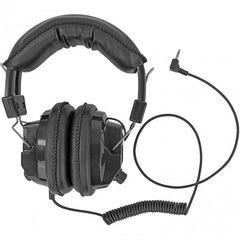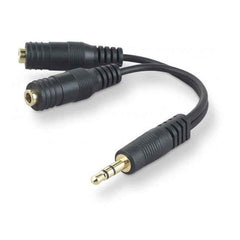Railroad Frequencies & Rail Scanning Ultimate Guide
Looking to listen to railroad communication, but not sure where to start? You've come to the right place, my friend.
Rail scanning and all the technical terms surrounding it can be a bit overwhelming, so we gathered all of the information you need to choose the best rail scanner.
Still have questions once you’ve read through this article?
The Railroad Scanning Guide Covers:
How to Listen to Railroad Communication
There are a few online streams and police scanner apps that can pick up rail communication, but what they broadcast is limited and depending on where you live, may not cover your area at all.
The best way to listen to all railroad communication in your area is with an analog scanner.
A railroad scanner is like an AM/FM radio in that it can receive radio signals, but not transmit them.
However, a railroad scanner is special because it can pick up unique radio signals that an average AM/FM cannot.
There are several names for railroad scanners that all mean the same thing:
- Analog Scanner
- Railroad Scanner
- Police Scanner
- Train Scanner
- Railroad Radio
- Train Radio
What to Listen To
Train Crews - Internal Communication
Listen to train staff communicate with one another.
You can hear conductors, trainmen, engineers, firefighters, passenger train crew members, Chief of On-Board Services, stewards, dining car attendants, kitchen staff, attendants and more.
This is popular with passenger train listeners.
Train to Train
Hear passing trains’ communication with one another, as the name would suggest.
Railroad Dispatcher
Railroad dispatchers are popular because you can listen to communication with all trains incoming and outgoing.
Railroad Maintenance Crews
Listen to maintenance crews discuss things such as snow removal, general maintenance, line closures, and other issues.
Railroad Police
Railroads have their own police, which handle things like rail yard security and crime prevention. Yes, even the graffiti that reveals your childlike wonder at railroad crossings.
It can be interesting to monitor unruly train passengers and rail yard trespassers, but that kind of action is hard to come by.
Who Uses Railroad Scanners?
- Rail fans
- Amateur Radio Hobbyists
- Emergency personnel (firefighters, police, EMS, etc.)
- Railroad staff
Anyone can use a railroad scanner to hear what’s going on in their area. Public airwaves in the US are free to listen to.
A handful of states have restrictions regarding using a scanner in your vehicle, so here is a detailed explanation of scanner laws in the US.
How to Buy a Railroad Scanner

There are a lot of railroad scanners on the market and, like most electronics, you get what you pay for. There are 4 main things to consider when buying a railroad scanner:
Frequency Bands
Over 99% of all railroad communication can be picked up with an analog scanner.
We discuss different frequency bands in greater detail later in Chapter 7 of this article, Railroad Scanner Frequencies.
Every scanner we sell can pick up analog signals. That means that all digital scanners can also pick up analog, but you’re a smart cookie, you knew that.
Number of Channels
Railroad scanners are like an AM/FM radio in that they have a certain number of preset “channels” you can program.
We recommend buying a railroad scanner with at least 200 channels available for programming, which every rail scanner we offer has:
- BC125AT = 500 Alpha-Tagged channels
- SR30C = 500 channels
There are 97 channels that the American Association of Railroads (AAR) has assigned for rail communication.
As most rail-fans will have these 97 channels programmed permanently, the remaining channel space available in your scanner will be reserved for local and regional rail channels.
Railroad Scanner Manufacturers
There are two companies that manufacture railroad scanners:
Both are quality manufacturers that offer a 1-year warranty & comparable scanner models, but the two best railroad scanners are the:
- Uniden SR30C
- Uniden BC125AT
Where Will You be Listening
There are 2 types of railroad scanners:
- Handheld - Handheld scanners are portable and can be carried around like a walkie-talkie.
- Home & Vehicle - Vehicle police scanners can be installed in the dashboard of a vehicle like a car radio. Home or "base" scanners are typically used in one location.
While the type of scanner you buy is based solely on your own personal preference, we recommend buying a handheld scanner.
Handheld scanners account for 90% of all scanner sales.
This will allow you to listen from home, and closer to the tracks.
What to Buy with your Railroad Scanner
Railroad Scanner Antenna

If you plan on scanning from your home or vehicle, you may want a mounted antenna to increase range.
30-35 miles is the ballpark range on all scanners using the stock on-set antenna, but the following factors affect reception:
- Topography (hills, trees, etc.)
- Transmission locations
- Signals work on line-of-sight, not satellites
- Weather
The type of antenna you need varies greatly based on where you live, what you want to listen to, what types of structures are nearby (buildings, trees, hills) that may block signals, and several other considerations.
Contact us and we can help you find the best scanner antenna or view our Antenna Buyer's Guide.
Pro tip: The scanner is the priority; add antenna later to increase signal.
Headset

If you plan on listening to rail traffic while on a passenger train, earphones are a must (that is, unless you wanna be That Guy).
If you listen outside, near the rail yard, it can get very loud, so over-ear headphones are highly recommended.
Splitter

We’ve found that a good portion of rail fans are young “PBS Kids.”
Though they may be Thomas the Train and Edward the Blue Engine fans first and foremost, your grand(son/daughter) might be interested in picking up the hobby.
In that case, they’re probably interested in listening to the same railroad scanner as you. This is where headphones and a two-way splitter come into play.
Batteries

Handheld railroad scanners typically last 4-6 hours per charge, but it’s best to have an extra set of batteries if you’re riding on an Amtrak train, or you do not have access to a power outlet.
All handheld railroad scanners use AA batteries.
AC (wall) and DC (car) Charger


All handheld scanners come with a USB cord, but no AC or DC adapter as they manufacture one model worldwide.
You will need to purchase an AC (wall) adapter to charge at home and a DC (car) adapter to charge in your vehicle.
Railroad Scanner Programming
While programming each rail scanner is unique, in our experience, analog programming isn’t as difficult as digital programming
The BC125AT_SS and SR30C_SS programming software is more plug-and-play copy-paste than other scanner software, but ultimately, there’s still a learning curve.
In other words, we program!
See “Railroad Scanner Frequencies” below for how to find rail scanner frequencies.
Rail frequencies have essentially remained the same since they were established. They aren’t written in stone, but there’s no reason to change them now.
You will be able to add channels as you listen and find them, but programming is not a big part of rail scanning. You can have your rail scanner professionally programmed as well.
Railroad Scanner Frequencies
Railroad scanning in the US and Canada is fairly straight forward thanks to the American Association of Railroads (AAR).
The AAR assigned channel numbers to all 96 frequencies in the 160-161 MHz band.
| Channel Number | Frequency | Channel Number | Frequency | |
|---|---|---|---|---|
| 2 | 159.810 | 52 | 160.890 | |
| 3 | 159.930 | 53 | 160.905 | |
| 4 | 160.050 | 54 | 160.920 | |
| 5 | 160.185 | 55 | 160.935 | |
| 6 | 160.200 | 56 | 160.950 | |
| 7 | 160.215 | 57 | 160.965 | |
| 8 | 160.230 | 58 | 160.980 | |
| 9 | 160.245 | 59 | 160.995 | |
| 10 | 160.260 | 60 | 161.010 | |
| 11 | 160.275 | 61 | 161.025 | |
| 12 | 160.290 | 62 | 161.040 | |
| 13 | 160.305 | 63 | 161.055 | |
| 14 | 160.320 | 64 | 161.070 | |
| 15 | 160.335 | 65 | 161.085 | |
| 16 | 160.350 | 66 | 161.100 | |
| 17 | 160.365 | 67 | 161.115 | |
| 18 | 160.380 | 68 | 161.130 | |
| 19 | 160.395 | 69 | 161.145 | |
| 20 | 160.410 | 70 | 161.160 | |
| 21 | 160.425 | 71 | 161.175 | |
| 22 | 160.440 | 72 | 161.190 | |
| 23 | 160.455 | 73 | 161.205 | |
| 24 | 160.470 | 74 | 161.220 | |
| 25 | 160.485 | 75 | 161.235 | |
| 26 | 160.500 | 76 | 161.250 | |
| 27 | 160.515 | 77 | 161.265 | |
| 28 | 160.530 | 78 | 161.280 | |
| 29 | 160.545 | 79 | 161.295 | |
| 30 | 160.560 | 80 | 161.310 | |
| 31 | 160.575 | 81 | 161.325 | |
| 32 | 160.590 | 82 | 161.340 | |
| 33 | 160.605 | 83 | 161.355 | |
| 34 | 160.620 | 84 | 161.370 | |
| 35 | 160.635 | 85 | 161.385 | |
| 36 | 160.650 | 86 | 161.400 | |
| 37 | 160.665 | 87 | 161.415 | |
| 38 | 160.680 | 88 | 161.430 | |
| 39 | 160.695 | 89 | 161.445 | |
| 40 | 160.710 | 90 | 161.460 | |
| 41 | 160.725 | 91 | 161.475 | |
| 42 | 160.740 | 92 | 161.490 | |
| 43 | 160.755 | 93 | 161.505 | |
| 44 | 160.770 | 94 | 161.520 | |
| 45 | 160.785 | 95 | 161.535 | |
| 46 | 160.800 | 96 | 161.550 | |
| 47 | 160.815 | 97 | 161.565 | |
| 48 | 160.830 | |||
| 49 | 160.845 | |||
| 50 | 160.860 | |||
| 51 | 160.875 |
There are a few exceptions and oddities around the US and for a detailed breakdown visit RadioReference.
Railroad Scanning FAQ
How far away will my railroad scanner work?
- About 30-35 miles.
- Potentially up to 60 miles with a home/vehicle antenna.
How do I program my railroad scanner?
- We can program your scanner with all US rail frequencies.
- We can still program if you did not purchase from us or already have your scanner.
- Programming each scanner is unique and we discuss how to program each scanner on its product page.
What is the best railroad scanner?
- We recommend the Uniden SR30C. It is the latest and greatest analog scanner.
- The BC125AT is older, but generally just as capable.
Are railroad scanners legal?
Yes. Here is an article that goes into great detail regarding scanning laws in the US.






































